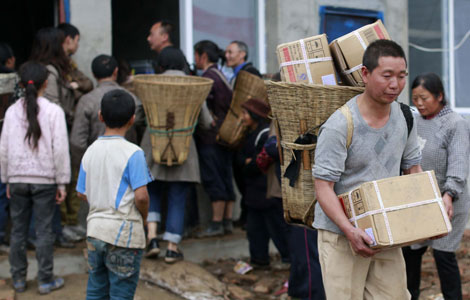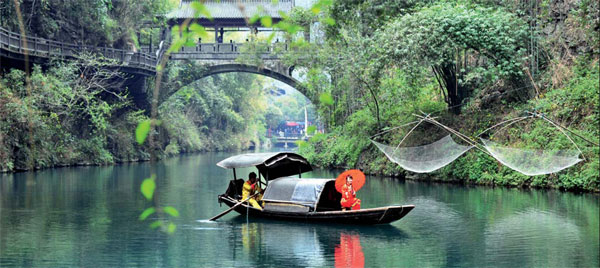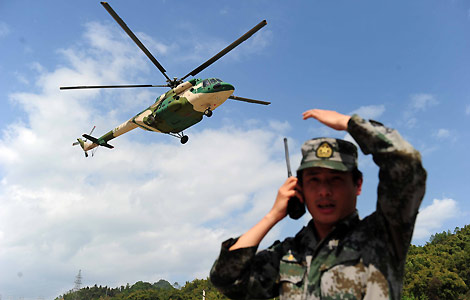Unsung beauty
Updated: 2013-04-26 07:23
(China Daily)
|
||||||||
|
The village on the water at the Three Gorges Tribe Scenic Spot. Provided to China Daily |
Yichang, with its history, culture and natural beauty, is worth exploring
The second largest city in Hubei province, central China, Yichang is blessed and cursed with its proximity to the Three Gorges Dam.
Lying on the northern bank of the Yangtze River, it is just 40 kilometers from the world's largest dam project, which attracts visitors from China and abroad, most of whom bypass the city on their way to see it.
Yichang, which at one time was the gateway to the Yangtze River, is used by the majority of tourists simply as the end point of a Three Gorges river cruise and seldom seen as an attraction in itself or a point for launching trips further downstream.
Three-night river cruises from Chongqing to Yichang, usually end with a rapid exit to Wuhan and other major cities without even a night in Yichang.
But the city offers a wealth of attractions for visitors to explore, with a history that stretches back 4,000 years. Among them are numerous historical and cultural spots, as well as scenes of natural beauty that could have come straight out of a work of art.
It is the birthplace of Chu culture, the hometown of the famous Chinese beauty Wang Zhaojun who lived during the Western Han Dynasty (206 BC-AD 24) and of the patriotic poet Qu Yuan from the Warring States Period (475-221BC).
Using its proximity to the Three Gorges Dam as leverage, Yichang now hopes to draw tourists in to experience its abundant attractions in an effort to boost tourism to the city by 2020.
Here are some of Yichang's main attractions:
1. Qingjiang River

This national forest park is fast becoming one of Yichang's more popular tourist attractions. Located in Changyang Tujia Ethnic Group Autonomous County of Yichang, it was named one of China's 5A-class scenic spots, the nation's top level, in January 2013.
In fact, Qingjiang River encompasses all the scenic spots between Geheyan Dam and Yanchi Spring along the Qingjiang River.
The river originates in Longdonggou, an area of Lichuan city in western Hubei province, and flows through Enshi county, Changyang county, and Badong county, before emptying into the Yangtze River.
There is an old Chinese saying that "The 800-li Qingjiang River is as beautiful as a painting." (Li is a unit of length equal to 0.5 kilometers) The area is famous for its magnificent mountains and rivers and offers great opportunities for hiking or boat trips.
Qingjiang River is also regarded as the mother river of the Tujia people who live in the area. The Tujia are known for their singing and traditional Baishou Dance, a 500-year-old collective dance that uses 70 ritual gestures to represent war, farming, hunting, courtship and other aspects of traditional life. Regular performances are put on for visitors
2. The Three-Gorges Tribe Scenic Spot
The Three-Gorges Tribe Scenic Spot, also known as the Three Gorges Household, is officially designated as a "Protected Center of the Popular Culture and Art of the Three Gorges".
Located in Xiling Gorge, between the Three Gorges Dam and Gezhouba Dam, the mountains and streams here create a scene worthy of the most beautiful landscape paintings.
Lying in the "Two Dams, One Gorge" tourism area, it is the only scenic spot in the region unaffected by the dams.
The spot has three main areas - the village on the water, the brook-side village and the mountaintop village - and is one the top 10 tourist attractions in Hubei province.
The area is blessed with abundant cultural and natural attractions. The first sight on entering it is of green mountains covered by mist against a backdrop of shimmering blue water.
For generations local people have lived off the mountains and water here, and visitors are likely to see young women singing as they pass by on sailboats, men casting nets into the water to catch fish, or women washing clothes by the riverside.
3. Three Visitors Cave and Park
Also known as Sanyou Cave, Three Visitors Cave and Park is around 10 kilometers from Yichang.
The cave wall is inscribed with poetry with a story behind it. It is said that Bai Juyi, one of China's greatest poets of the Tang Dynasty (AD 618-907), his younger brother and Yuan Zhen, another well-known poet of the time, spent some time in the cave and while there Bai inscribed a poem on the wall. This story then inspired other poets and scholars to go to the cave to inscribe their own poetry.
Also worth taking a look at in the park are views of the Yangtze River, old military defense walls, some ancient city remains and a pavilion with views of the river.
China Daily
(China Daily 04/26/2013 page22)
Most Viewed
Editor's Picks

|

|

|

|

|

|
Today's Top News
Alibaba pays $586 million for stake in Sina Weibo
Three buried after lab explosion
Willem-Alexander ready to be Dutch King
Can earthquakes be predicted?
City unites to say farewell
Beauties turn entrepreneurs
Small stores rely on new retail revolution
Flooding season nears in Ya'an
US Weekly

|

|















